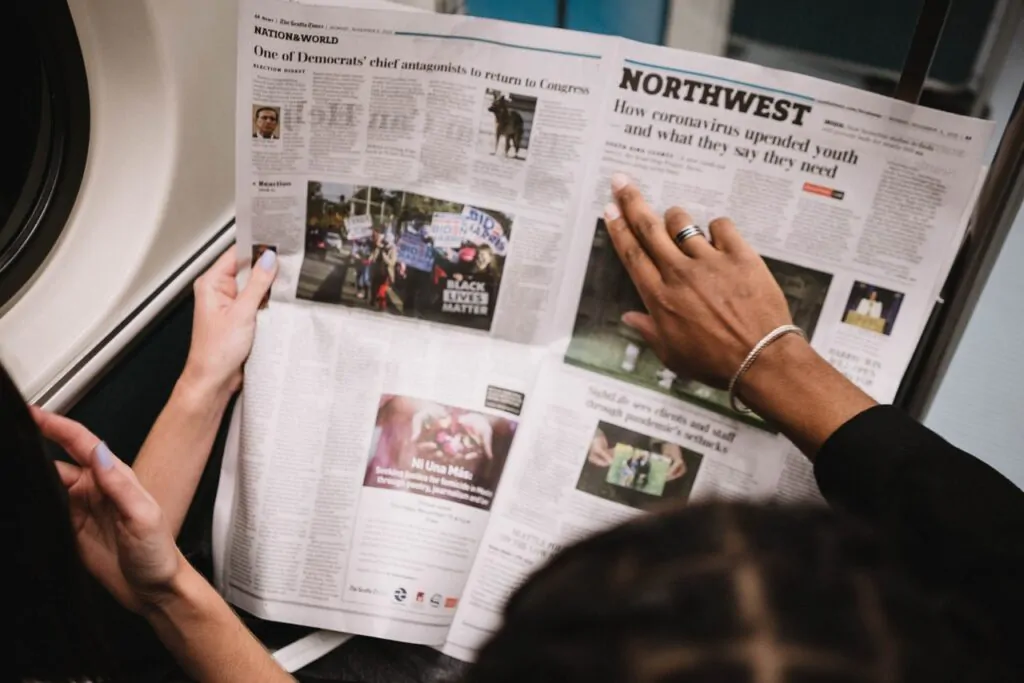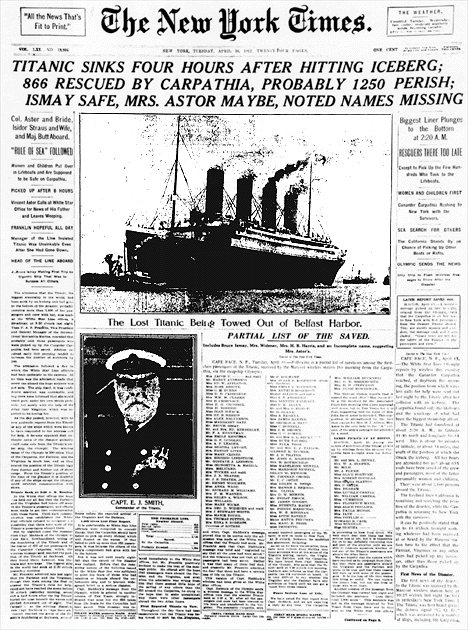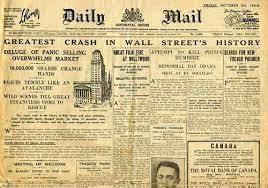‘Sell and tell’ with this ‘how to guide’ and our best example of newspaper headlines.
When looking through a newsstand, what’s the first thing most people notice? The answer is, of course, the newspaper headlines.
When done well, a good headline will grasp the attention of a passerby and make them want to pick up that paper and investigate the news story. The power of a newspaper headline shouldn’t be underestimated. They can be the difference between someone buying the paper and someone merely walking by.
Nowadays, headlines have even more power. For online publications, headlines not only have to grab the attention of the prospective reader, but they are also important for search engine optimization. Today, a reader is just as, if not more, likely to come across an article via an internet search as they are on a newsstand. Before deep diving into how to write newspaper headlines, we should look at their purpose.
Contents
- The Purpose of Newspaper Headlines
- How To Write a Newspaper Headline
- Step 1. Know Your Story
- Step 2. Be Short and Catchy
- Step 3. Think Outside The Box
- Step 4. Embrace The Rules
- Step 5. Practice And Take Help When Offered
- Step 6. Consider The Tact Test (Taste, Attractiveness, Clarity, Truth)
- Step 7. Optimize for Online
- Iconic Examples of Newspaper Headlines
- 1. Men Walk On Moon
- 2. Stay At Home
- 3. Kennedy Is Killed By Sniper As He Rides In Car In Dallas; Johnson Sworn In On Plane
- 4. Titanic Sinks Four Hours After Hitting Iceberg
- 5. Greatest Crash in Wall Street’s History
- 6. Mandela Goes Free Today
- FAQs About the Best Examples of Newspaper Headlines
The Purpose of Newspaper Headlines

The purpose of a headline is to ‘tell and sell’ a story. In other words, they are there to grasp the target audience’s attention and make them want to read more. Great headline writers know that there are several ways to do this. For instance, when iconic news stories break, articles can become representations of these moments in history. This is done when a newspaper captures the general feeling of the public after such an event.
For example, on November 5th, 2008, The New York Times ran the front page headline “Obama: Racial Barrier Falls in Decisive Victory.” This headline grasped the reader’s attention. It instantly became an iconic part of the story it was telling.
German newspaper Bild’s ‘Wir sind Papst’ (We Are Pope) is another example. They used this headline after a German was voted to become Pope Benedict XVI in 2005. Of course, not every headline will have that power, as not every news story is iconic. However, clever headline writers know other ways to draw people in.
A headline can tell and sell with shock. Just consider one of the most iconic tabloid headlines of all time, Freddy Starr Ate My Hamster. In UK news writing circles, that headline that appeared in The Sun newspaper in 1986 is still discussed. Freddy Starr was one of the most famous comedians in the country at the time, and the shocking nature of the headline made the newspaper almost impossible to ignore.
Another tactic that is often used effectively to ‘tell and sell’ is humor. Whether they are to your taste or not, puns can be a great tool here. For instance, the Kodiak Daily Mirror’s headline describing an undergarment crime heist was widely praised. It read: ‘Underwear bandit caught, admits brief crime spree.’ The purpose of headlines is to capture a reader’s attention while connecting the title to the story. How you choose to do that will depend on your style and the news story itself.
How To Write a Newspaper Headline
You now know the importance of a headline and why it exists. You also know several effective techniques to capture a potential reader’s attention. Now we will break down the mechanics of this tiny piece of content and help you craft your own headlines and subheadings. If you want to work in news, you should know the following about headlines.
Step 1. Know Your Story
When it comes to headline writing, the first step is to identify the most important information within the story. Next, the headline needs to be an accurate representation of the news article. Otherwise, the reader won’t trust your publication in the future. You should ask yourself, ‘would the reader expect this article from this news headline?’ The answer should be ‘yes.’
Step 2. Be Short and Catchy
Catchy headlines are gold dust, and catchy headlines are not long. So, ideally speaking, your news headlines should be ten words at maximum. Headlines are primarily written in a compressed style, similar to a telegraph. Therefore, lose articles ‘a, an’ and, more often than not, ‘the.’ You might also be interested in learning how to write an article critique.
Step 3. Think Outside The Box
It would be best if you also mustered up all your creativity, as following the step is all well and good, but it’s hard to resist a bit of panache. Use exciting verbs while avoiding PR speak, such as ‘announce,’ ‘launch,’ and ‘partnered.’ They will make the article more like a press release and reduce overall interest. Be creative around the headline; if you need to, use the subheading to expand on this.
Step 4. Embrace The Rules
Regarding headline-ese, verbs are presented in the simple present tense. So, for instance, instead of the headline being ‘Lebron Has Signed The Contract,’ it would be ‘Lebron Signs Contract.’ If it is a future event, then an infinitive is used, with ‘to’ followed by an action verb – ‘Lebron To Sign Contract.’
Although it may seem contradictory after that last example, it is primarily the surname used when writing a headline about a person-centered story. Of course, exceptions (such as above) exist where their forename more widely knows the specified person.
It would be best if you also didn’t use unspecified pronouns, as this can lead to confusion. For instance, if you were reporting on Manchester United winning three trophies in one season in 1999, you wouldn’t write ‘They Won The Treble.’ Something along the lines of ‘Manchester Utd Win The Treble’ is far superior.
Step 5. Practice And Take Help When Offered
Like any other type of writing, the more you write headlines, the better you will get at it. It should also be noted that newsrooms are collaborative places, so run your best attempts by your colleagues. They will tell you what they like, what they don’t, and what they don’t get.
And if someone within the business doesn’t get it, it’s likely that your readers won’t either. It’s not just your colleagues that can help. There are also templates of the different headlines used throughout the years. If you are struggling for inspiration, try those out and see how they fit your story.
Step 6. Consider The Tact Test (Taste, Attractiveness, Clarity, Truth)
When you land on a headline, you should mentally run it through the TACT test. You can do this by asking the following questions.
- Is it in good taste, or could elements of it be interrupted that way?
- Does it sell the story and grab the reader’s attention? Is it attractive?
- Is it clear and accurate?
- Probably the most important out of all of these – is it factual? Will the readers feel lied to after they digest the story? A good headline has to be true to the story.
If the answer to the above is ‘no,’ you need to restart the process.
Step 7. Optimize for Online
Of course, the above are tips for newspaper headlines. That being said, you must also observe them when writing online.
However, when it comes to online, there are other considerations you must take into account. For instance, having your articles appear at the top of a search engine query could be the difference between them being ignored and read.
Thankfully, there are some valuable resources for this. For instance, NPR has even published an article to help journalists write digital headlines that readers and Google will love. There are also plenty of headline analyzers (although the one linked is the best we’ve found!) out there that have already helped content marketing firms make the most of their work.
Iconic Examples of Newspaper Headlines
These examples both ‘tell and sell’ the story. They became iconic documents of history after the event and remained so.
1. Men Walk On Moon
The New York Times ran with the above headline on July 21st, 1969. It was an iconic moment in America’s history, and the writers got it exactly right.
They wrote a four-word sentence that got the story across to readers, detailing further important information in the subheading: ‘Astronauts land on plain; collect rocks, plant flags.’ This is one of the best headline examples out there because it tells the story that the world is waiting to hear while making readers want to read more.
2. Stay At Home
From one generational moment to another, this one isn’t even close to being as cheerful. It was in 2020 when the San Francisco Chronicle was detailing lockdown orders due to the coronavirus pandemic sweeping the nation.
It followed up its simple three-word headline with the subhead ‘6 Bay Area counties order nearly 7 million people to shelter in place. The newspaper headline demanded that readers pick up the newspaper to read more. It did so with a simple statement that thoroughly told the story.
3. Kennedy Is Killed By Sniper As He Rides In Car In Dallas; Johnson Sworn In On Plane
The death of JFK was a story that rocked a nation and The New York Times got their headline of the story just right when they wrote the above. It passes the TACT test easily, as it is not in bad taste and is accurate, clear, and true. It breaks the rules a little with its length, but there are exceptions to every rule.
4. Titanic Sinks Four Hours After Hitting Iceberg

Similar to the JFK headline, what works with the above is clarity. It tells the story of the unsinkable ship that sank and enticed readers to pick up the paper to read more. The New York Times ran with that headline, as it became an iconic part of the reaction to the Titanic.
5. Greatest Crash in Wall Street’s History

The Daily Mail’s headline about the 1929 Wall Street crash signaled the end of the roaring 20s and the start of The Great Depression. The headline demanded that you pick up the newspaper and read more.
6. Mandela Goes Free Today
Nelson Mandela being freed from prison was an iconic moment in the world’s history and one that City Press captured perfectly. They linked the future president by his surname to a story that the entirety of South Africa and the world was eager to read.
FAQs About the Best Examples of Newspaper Headlines
What is the difference between a newspaper headline and a news headline?
A newspaper headline is a heading for a story for a specific newspaper publication, whereas a news headline can be for other mediums, including online. Therefore, the writer of a newspaper headline doesn’t have to consider SEO or social media, whereas the writer of an online news headline does.
What are the 3 types of headlines?
There are far more than three types of headlines. Just look through any newspaper, and you will see a great variety, with feature stories, news stories, editorials, and adverts requiring far more than just three types of headlines.
When it comes to news stories, if you want to break them down into three areas, you could break them down into the following three areas: headlines that draw the reader in with the magnitude of the story, ones that capture the reader’s attention through shock, and headlines that use humor to grasp the passing reader.
For help with this topic, read our guide explaining what is persuasive writing?